|
|
#801 |
|
⊙▃⊙
|
Daily Suspicious0bserver's Weather Post:
January 8, 2014 What's in the sky tonight? January 8, 2014 -Jupiter’s moon Europa crosses Jupiter’s face from 6:47 to 9:29 p.m. EST, with its shadow following just 10 minutes behind. -Giant sunspot AR1944 is directly facing Earth and crackling with solar flares. Yesterday, Jan. 7th, an X1-class explosion in the sunspot's magnetic canopy hurled a CME in our direction. High-latitude sky watchers shoud be alert for auroras on Jan. 9th when the cloud is expected to arrive. NOAA forecasters estimate a 60% chance of polar geomagnetic storms. -The X1-flare that hurled the CME toward Earth also accelerated a swarm of high-energy protons in our direction. Effects of the proton fusillade are visible in this Jan. 7th coronagraph movie from the Solar and Heliospheric Observatory (SOHO). -The "snow" in this movie is caused by solar protons striking the spacecraft's CCD camera. A veritable blizzard of speckles develops as the CME emerges into full view. Indeed, many of the protons are accelerated by shock waves at the forefront of the expanding cloud. This ongoing radiation storm ranks S2 on NOAA storm scales. It is rich in "hard" protons with more than 100 MeV of energy, which accounts for the snowiness of the SOHO coronagraph images. According to NOAA, "passengers and crew in high-flying aircraft at high latitudes may be exposed to elevated radiation risk" during such a storm. The source of all this activity is AR1944, one of the biggest sunspots of the past decade. The sprawling active region is more than 200,000 km wide and contains dozens of dark cores. Its primary core, all by itself, is large enough to swallow Earth three times over. To set the scale of the behemoth, Karzaman Ahmad inserted a picture of Earth in the corner of this picture he took on Jan. 7th from the Langkawi National Observatory in Malaysia. -More flares are in the offing. The sunspot has an unstable 'beta-gamma-delta' magnetic field that is likely to erupt again today. NOAA forecasters estimate an 80% chance of M-class flares and a 50% chance of X-flares on Jan. 8th. 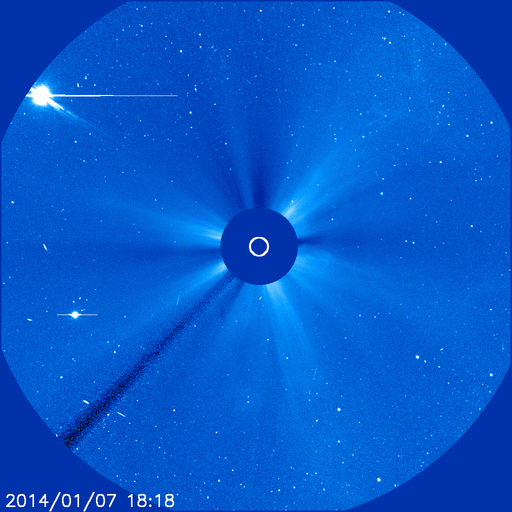 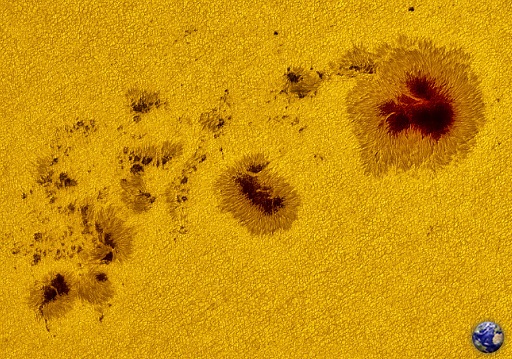 Astro Picture of the Day: January 8, 2014  Sunsets may be the most watched celestial event, but lately sunsets have even offered something extra. A sunspot so large it was visible to the naked eye is captured in Swiss skies in this sunset scene from January 5, crossing left to right near the center of a solar disk dimmed and distorted by Earth's dense atmosphere. Detailed views reveal a large solar active region composed of sunspots, some larger than planet Earth itself. Cataloged as active region AR 1944, on January 7 it produced a substantial solar flare and a coronal mass ejection (CME) forecast to reach Earth. The CME could trigger geomagnetic storms and aurora on January 9.
__________________
1st in Kommisar's 2009 SM Tournament 1st in I Love You`s 2009 New Year`s Tournament 3rd in EnR's Mashfest '08 tournament 5th in Phynx's Unofficial FFR Tournament 9th in D3 of the 2008-2009 4th Official FFR Tournament 10th in D5 of the 2010 5th Official FFR Tournament 10th in D6 of the 2011-2012 6th Official FFR Tournament FMO AAA Count: 71 FGO AAA Count: 10 Bluearrowll = The Canadian player who can not detect awkward patterns. If it's awkward for most people, it's normal for Terry. If the file is difficult but super straight forward, he has issues. If he's AAAing a FGO but then heard that his favorite Hockey team was losing by a point, Hockey > FFR PS: Cool AAA's Terry - I Love You An Alarm Clock's Haiku beep beep beep beep beep beep beep beep beep beep beep beep beep beep beep beep beep - ieatyourlvllol |
|
|

|
|
|
#802 |
|
⊙▃⊙
|
Daily Suspicious0bserver's Weather Post:
January 9, 2014 What's in the sky tonight? January 9, 2014 -A large coronal mass ejection (CME) from the Sun should start hitting Earth's magnetosphere around 8:00 UT January 9th (3 a.m. EST, midnight PST). -The CME comes from a big sunspot region that's currently visible to the unaided eye through a safe solar filter or a #14 rectangular arc-welder's filter. -NOAA forecasters estimate a 90% chance of geomagnetic storms on Jan. 9th when a CME is expected to hit Earth's magnetic field. The speed of the solar wind around Earth could spike to 700 km/s (1.6 million mph) shortly after the impact, sharply compressing Earth's magnetosphere. High-latitude sky watchers should be alert for auroras. -Venus is turning its night side toward Earth as it approaches inferior solar conjunction on Jan. 11th. Less than 1% of Venus's sunlit hemisphere is now facing us, which means the planet looks like a razor-thin crescent. If you have a GOTO telescope, command it to slew to Venus. It's visible even in broad daylight. -Shahrin Ahmad of Sri Damansara, Malaysia, took these pictures on Jan. 2nd, 6th and 8th using a 4.5 inch telescope. "It us very interesting to see how fast Venus changes in only 6 days! Today the thinning crescent is only 0.7% illuminated at a distance of 7o from the sun." 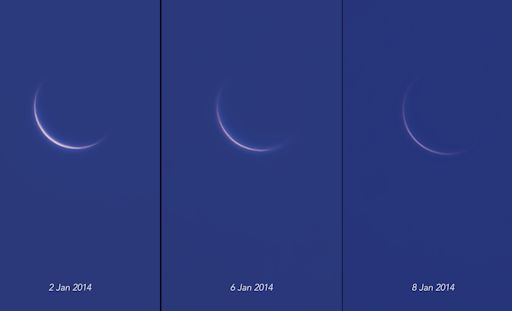 Astro Picture of the Day: January 9, 2014 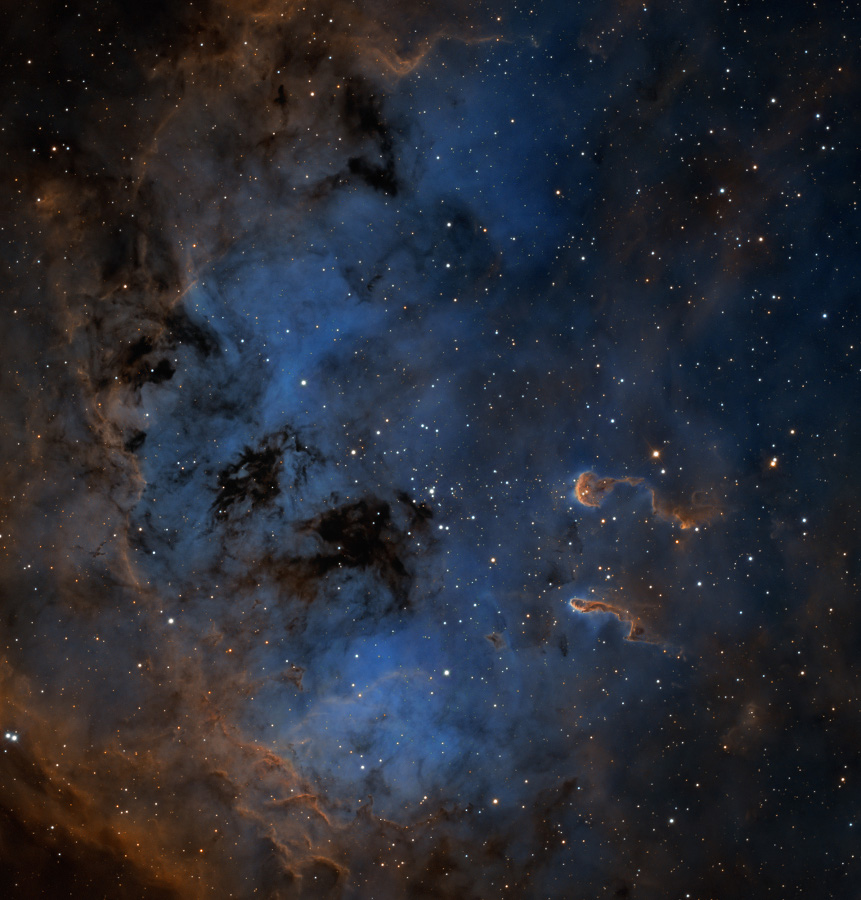 This telescopic close-up shows off the otherwise faint emission nebula IC 410 in striking false-colors. It also features two remarkable inhabitants of the cosmic pond of gas and dust below and right of center, the tadpoles of IC 410. The picture is a composite of images taken through narrow band filters. The narrow band image data traces atoms in the nebula, with emission from sulfur atoms in red, hydrogen atoms in green, and oxygen in blue. Partly obscured by foreground dust, the nebula itself surrounds NGC 1893, a young galactic cluster of stars that energizes the glowing gas. Composed of denser cooler gas and dust the tadpoles are around 10 light-years long, potentially sites of ongoing star formation. Sculpted by wind and radiation from the cluster stars, their tails trail away from the cluster's central region. IC 410 lies some 12,000 light-years away, toward the constellation Auriga.
__________________
1st in Kommisar's 2009 SM Tournament 1st in I Love You`s 2009 New Year`s Tournament 3rd in EnR's Mashfest '08 tournament 5th in Phynx's Unofficial FFR Tournament 9th in D3 of the 2008-2009 4th Official FFR Tournament 10th in D5 of the 2010 5th Official FFR Tournament 10th in D6 of the 2011-2012 6th Official FFR Tournament FMO AAA Count: 71 FGO AAA Count: 10 Bluearrowll = The Canadian player who can not detect awkward patterns. If it's awkward for most people, it's normal for Terry. If the file is difficult but super straight forward, he has issues. If he's AAAing a FGO but then heard that his favorite Hockey team was losing by a point, Hockey > FFR PS: Cool AAA's Terry - I Love You An Alarm Clock's Haiku beep beep beep beep beep beep beep beep beep beep beep beep beep beep beep beep beep - ieatyourlvllol |
|
|

|
|
|
#803 |
|
⊙▃⊙
|
Daily Suspicious0bserver's Weather Post:
January 10, 2014 What's in the sky tonight? January 10, 2014 -Look left of the Moon at nightfall for the Pleiades, as shown here. The Pleiades are straight above the Moon by about 8 or 9. -Bright Capella high overhead and bright Rigel in Orion's foot, both magnitude 0, have almost the same right ascension — so they cross your sky’s north-south meridian at almost the same time. Capella passes closest to straight overhead around 10 p.m., depending on how far east or west you live in your time zone. (It goes exactly through the zenith if you're at latitude 46° north: Portland, Oregon; Montreal; central France.) So, when Capella is passing closest to the zenith, Rigel always marks true south over your landscape. -Giant sunspot AR1944 has not unleashed a significant flare in more than 48 hours. The growing quiet could be the calm between storms. AR1944 has an unstable 'beta-gamma-delta' magnetic field that harbors energy for X-class flares. -As predicted, a CME hit Earth's magnetic field on Jan. 9th (20:00 UT). The impact was weaker than expected, however, and it failed to produce widespread geomagnetic storms. Nevertheless, some beautiful auroras appeared around the Arctic Circle. Harald Albrigtsen sends this picture from Tromsø, Norway. It was dark in Norway when the CME arrived, so observers there witnessed a nice display. By the time night fell over North America, however, the lights had faded. US observers saw nothing remarkable. More auroras are possible on Jan. 10th as Earth passes through the magnetic wake of the CME. NOAA forecasters estimate a 85% chance of polar geomagnetic storms before the day is over.   Astro Picture of the Day: January 10, 2014 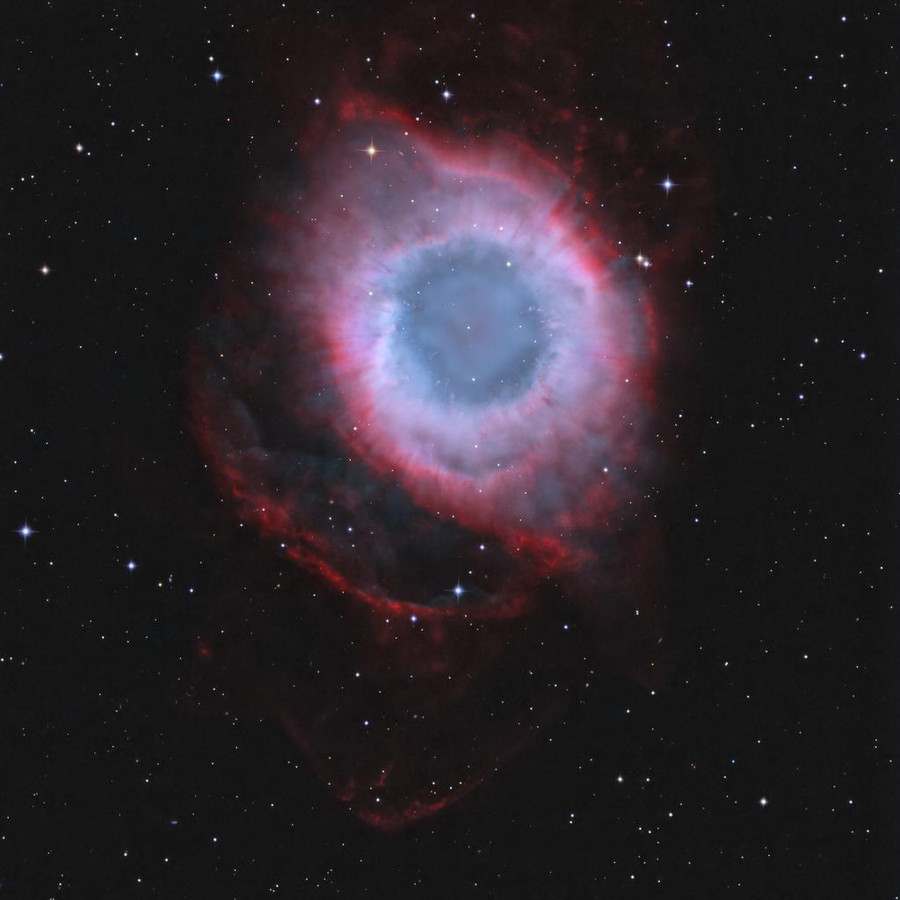 A mere seven hundred light years from Earth, in the constellation Aquarius, a sun-like star is dying. Its last few thousand years have produced the Helix Nebula (NGC 7293), a well studied and nearby example of a Planetary Nebula, typical of this final phase of stellar evolution. A total of 28.5 hours of exposure time have gone in to creating this deep view of the nebula. Combining narrow band image data from emission lines of hydrogen atoms in red and oxygen atoms in blue-green hues, it shows remarkable details of the Helix's brighter inner region, about 3 light-years across, but also follows fainter outer halo features that give the nebula a span of well over six light-years. The white dot at the Helix's center is this Planetary Nebula's hot, central star. A simple looking nebula at first glance, the Helix is now understood to have a surprisingly complex geometry.
__________________
1st in Kommisar's 2009 SM Tournament 1st in I Love You`s 2009 New Year`s Tournament 3rd in EnR's Mashfest '08 tournament 5th in Phynx's Unofficial FFR Tournament 9th in D3 of the 2008-2009 4th Official FFR Tournament 10th in D5 of the 2010 5th Official FFR Tournament 10th in D6 of the 2011-2012 6th Official FFR Tournament FMO AAA Count: 71 FGO AAA Count: 10 Bluearrowll = The Canadian player who can not detect awkward patterns. If it's awkward for most people, it's normal for Terry. If the file is difficult but super straight forward, he has issues. If he's AAAing a FGO but then heard that his favorite Hockey team was losing by a point, Hockey > FFR PS: Cool AAA's Terry - I Love You An Alarm Clock's Haiku beep beep beep beep beep beep beep beep beep beep beep beep beep beep beep beep beep - ieatyourlvllol |
|
|

|
|
|
#804 |
|
( ¯u¯)-b
|
!! this is really cool. i might start coming here regularly just to read these haha
|
|
|

|
|
|
#805 |
|
⊙▃⊙
|
Daily Suspicious0bserver's Weather Post:
January 11, 2014 What's in the sky tonight? January 11, 2014 -Aldebaran shines below the Moon at dusk, as shown here. It swings around to the left of the Moon by about 11 p.m. -Jupiter’s Great Red Spot transits Jupiter’s central meridian around 9:30 p.m. EST. -Venus is at inferior conjunction, passing 5° north of the Sun today. -NOAA forecasters estimate a 35% chance of X-class solar flares on Jan. 11th. The likely source would be AR1944. The brooding sunspot has been quiet for days, but still poses a threat for strong eruptions. -The payload of a space weather balloon launched Jan. 8th by the students of Earth to Sky Calculus has been recovered from its landing site in Death Valley National Park. The purpose of the flight was to study a solar radiation storm in progress at the time of the launch. Analyzing the data may take a few days. These pictures were taken by a pair of Hero3+ cameras looking out of the payload capsule. The upper frame shows the Sierra Nevada mountain range, unusually brown for this time of year as California endures a historic drought. The lower frame captures the balloon popping at an altitude of approximately 100,000 feet. Click on each frame for a closer look. The landscape shot was made using the Hero3+'s new "superview mode"--a favorite of snowboarders and now, for the first time, balloonists! In addition to cameras, the payload contained an x-ray/gamma-ray dosimeter, a GPS altimeter, and a cryogenic thermometer. Together these instruments can form a complete thermal and radiation profile of the atmosphere throughout the flight. The students plan to pay special attention to data collected at aviation altitudes to learn how much radiation air travelers absorb during periods of high solar activity.  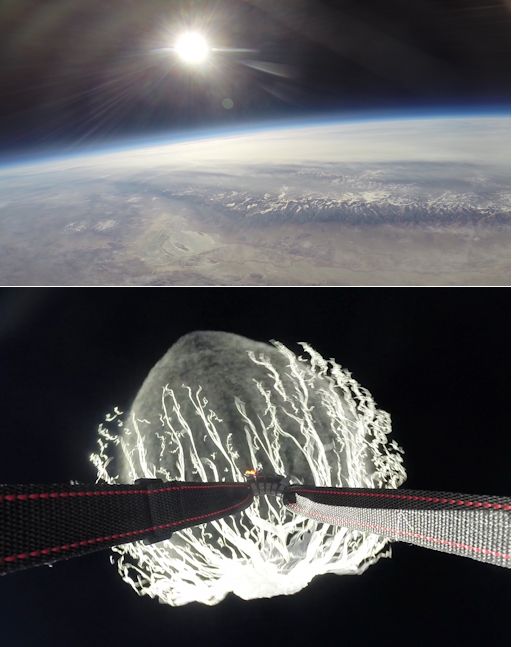 News Posted Today: January 10, 2014 Galaxies Trace Early Cosmic History  Astro Picture of the Day: January 11, 2014 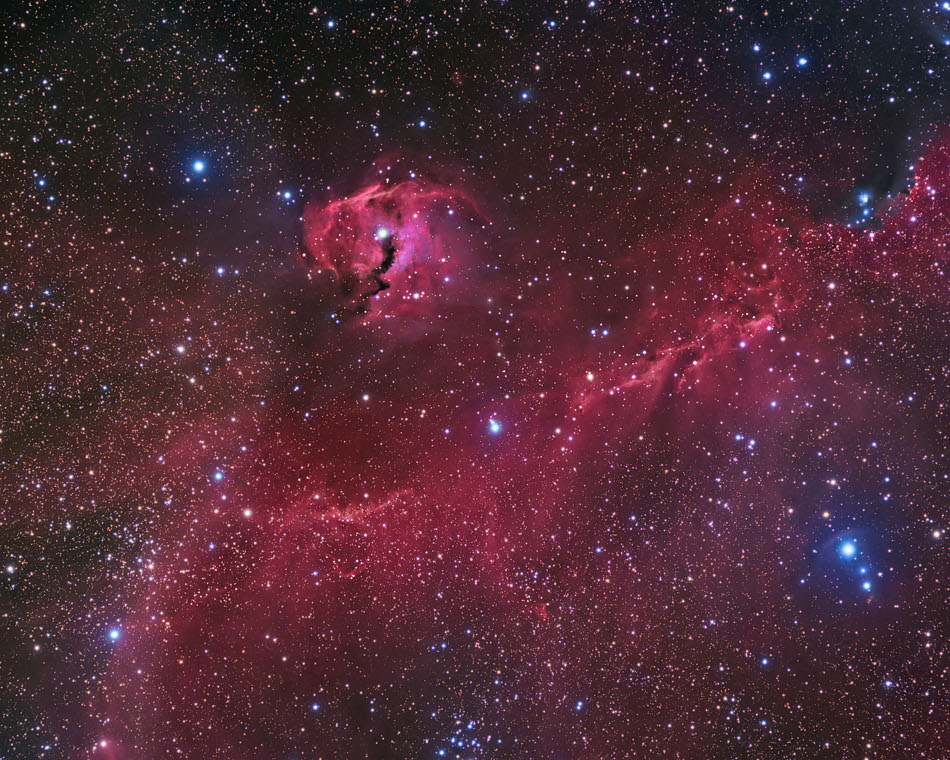 A broad expanse of glowing gas and dust presents a bird-like visage to astronomers from planet Earth, suggesting its popular moniker - The Seagull Nebula. This portrait of the cosmic bird covers a 1.6 degree wide swath across the plane of the Milky Way, near the direction of Sirius, alpha star of the constellation Canis Major. Of course, the region includes objects with other catalog designations: notably NGC 2327, a compact, dusty emission region with an embedded massive star that forms the bird's head (aka the Parrot Nebula, above center). Dominated by the reddish glow of atomic hydrogen, the complex of gas and dust clouds with bright young stars spans over 100 light-years at an estimated 3,800 light-year distance.
__________________
1st in Kommisar's 2009 SM Tournament 1st in I Love You`s 2009 New Year`s Tournament 3rd in EnR's Mashfest '08 tournament 5th in Phynx's Unofficial FFR Tournament 9th in D3 of the 2008-2009 4th Official FFR Tournament 10th in D5 of the 2010 5th Official FFR Tournament 10th in D6 of the 2011-2012 6th Official FFR Tournament FMO AAA Count: 71 FGO AAA Count: 10 Bluearrowll = The Canadian player who can not detect awkward patterns. If it's awkward for most people, it's normal for Terry. If the file is difficult but super straight forward, he has issues. If he's AAAing a FGO but then heard that his favorite Hockey team was losing by a point, Hockey > FFR PS: Cool AAA's Terry - I Love You An Alarm Clock's Haiku beep beep beep beep beep beep beep beep beep beep beep beep beep beep beep beep beep - ieatyourlvllol |
|
|

|
|
|
#806 |
|
⊙▃⊙
|
Daily Suspicious0bserver's Weather Post:
January 12, 2014 What's in the sky tonight? January 12, 2014 -Jupiter shines left of the nearly full Moon early this evening. Ganymede, the largest and brightest moon of Jupiter itself, slowly emerges out of eclipse from Jupiter's shadow around 10:21 p.m. EST. With a telescope, watch for this happening just off Jupiter's eastern limb. -NOAA forecasters estimate a 35% chance of X-class solar flares on Jan. 12th, most likely from AR1944. The brooding sunspot has been quiet for days, but still poses a threat for strong eruptions. -This weekend Venus is at inferior conjunction. That means it is passing almost directly between Earth and the sun. With its nightside facing Earth (almost perfectly), Venus looks like an incredibly slender crescent. On Jan. 11th in Targoviste, Romania, amateur astronomer Maximilian Teodorescu photographed Venus only 5 degrees from the sun. -"Taking extreme care not to point any unfiltered optics at the sun, I started to look for Venus through my 11-inch Celestron telescope," says Teodorescu. "The thin but very large crescent suddenly appeared into the field of view. It was surreal to watch the boiling atmospheric arc of the planet just above the sun in plain day. My wife immortalized the moment by taking a panoramic view from our clear-sky location." Observing Venus through a telescope can be dangerous. Even a quick inadvertent glimpse of magnified light from the nearby sun can cause serious eye damage. Anthony J. Cook of the Griffith Observatory has some advice for observers: "I have observed Venus at conjunction, but only from within the shadow of a building, or by adding a mask to the front end of the telescope to fully shadow the optics from direct sunlight. This is tricky with a refractor or a catadioptric, because the optics start at the front end of the tube. Here at Griffith Observatory, I rotate the telescope dome to make sure the lens of the telescope is shaded from direct sunlight, even through it means that the lens will be partially blocked when aimed at Venus. With our Newtonian telescope, I add a curved cardboard mask at the front end of the tube to shadow the primary mirror." Around the world, many people are applying these techniques to photograph Venus as it passes by the sun.  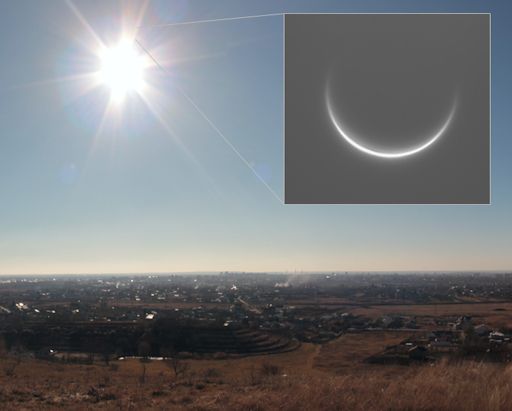 Astro Picture of the Day: January 12, 2014 Source: What does the universe look like on small scales? On large scales? Humanity is discovering that the universe is a very different place on every proportion that has been explored. For example, so far as we know, every tiny proton is exactly the same, but every huge galaxy is different. On more familiar scales, a small glass table top to a human is a vast plane of strange smoothness to a dust mite -- possibly speckled with cell boulders. Not all scale lengths are well explored -- what happens to the smallest mist droplets you sneeze, for example, is a topic of active research -- and possibly useful to know to help stop the spread of disease. The above interactive flash animation, a modern version of the classic video Powers of Ten, is a new window to many of the known scales of our universe. By moving the scroll bar across the bottom, you can explore a diversity of sizes, while clicking on different items will bring up descriptive information.
__________________
1st in Kommisar's 2009 SM Tournament 1st in I Love You`s 2009 New Year`s Tournament 3rd in EnR's Mashfest '08 tournament 5th in Phynx's Unofficial FFR Tournament 9th in D3 of the 2008-2009 4th Official FFR Tournament 10th in D5 of the 2010 5th Official FFR Tournament 10th in D6 of the 2011-2012 6th Official FFR Tournament FMO AAA Count: 71 FGO AAA Count: 10 Bluearrowll = The Canadian player who can not detect awkward patterns. If it's awkward for most people, it's normal for Terry. If the file is difficult but super straight forward, he has issues. If he's AAAing a FGO but then heard that his favorite Hockey team was losing by a point, Hockey > FFR PS: Cool AAA's Terry - I Love You An Alarm Clock's Haiku beep beep beep beep beep beep beep beep beep beep beep beep beep beep beep beep beep - ieatyourlvllol |
|
|

|
|
|
#807 |
|
⊙▃⊙
|
Daily Suspicious0bserver's Weather Post:
January 13, 2014 What's in the sky tonight? January 13, 2014 -Betelgeuse is lower right of the Moon this evening. Jupiter is to the Moon's lower left, with Pollux on beyond. Look far under the Moon for Procyon. -Blowing with gusts as fast as 800 km/s (1.8 million mph), a stream of solar wind is buffeting Earth's magnetic field. High-latitude sky watchers should be alert for auroras on Jan. 13th. -On Jan. 12th, a robotic arm on the ISS reached out and snagged another spaceship--Orbital Sciences Corporation's Cygnus cargo carrier. Cygnus reached the ISS on time despite a launch delay last Wednesday caused by stormy space weather. The docking on Sunday morning at 8:05 am EST marked the first successful contracted cargo delivery by Orbital Sciences. Only five hours before docking, the two spacecraft flew over the Netherlands where veteran satellite observer Marco Langbroek was waiting with his camera to take this picture. "The Cygnus cargoship was too faint to be seen by the naked eye for most of the pass, but around 5:57:05 UTC it briefly flared to mag +2 and the close duo ISS-Cygnus was suddenly and briefly well visible as a result," says Langbroek. "This picture shows the moment when the Cygnus flared." Cygnus delivered almost 2800 lbs of equipment and crew supplies to the space station. This includes dozens of new science experiments including 23 designed by students. One newly arrived investigation will study the behavior of ants in microgravity. Another will probe the decreased effectiveness of antibiotics during spaceflight--a possible problem for astronauts on long space journeys. Yet another will explore how different materials burn in microgravity to improve fire safety in future spacecraft. -Compare what Suspicious0bserver's mentioned about the fireball in his video today with the January 12 fireball orbital network, and see if there is any consistencies. On Jan. 12, 2014, the network reported 11 fireballs. (10 sporadics, 1 Canum Venaticid)  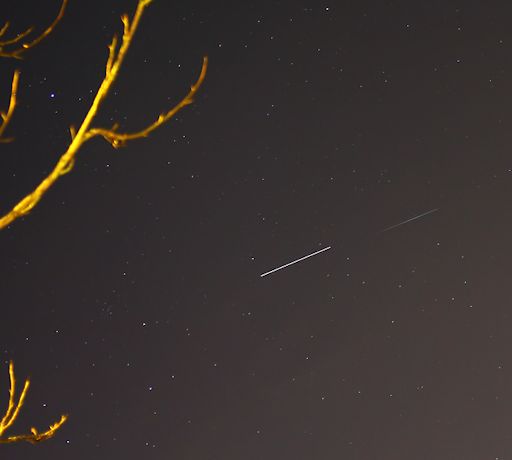  Astro Picture of the Day: January 13, 2014  What would it be like to visit the Moon? The first major fictional cinematic film exploring this enduring transcultural fantasy was titled Le voyage dans la lune (A Trip to the Moon) and made in 1902, becoming one of the most popular movies of the early years of the twentieth century. The silent film starred the filmmaker Georges Melies himself and portrayed a club of astronomers voyaging to the Moon and back. Pictured above is a frame from the movie that has become an enduring icon for both film and space. Alluding to a bullseye trajectory, the Man in the Moon is caricatured as being struck by the human-built spaceship. The entire 14-minute film is now freely available. Visiting the Moon remained a very popular topic even 67 years later in 1969 when humans first made an actual voyage. The movie: http://www.youtube.com/watch?v=_FrdVdKlxUk The movie rescored: http://www.youtube.com/watch?v=vNVmYxc6iZ4
__________________
1st in Kommisar's 2009 SM Tournament 1st in I Love You`s 2009 New Year`s Tournament 3rd in EnR's Mashfest '08 tournament 5th in Phynx's Unofficial FFR Tournament 9th in D3 of the 2008-2009 4th Official FFR Tournament 10th in D5 of the 2010 5th Official FFR Tournament 10th in D6 of the 2011-2012 6th Official FFR Tournament FMO AAA Count: 71 FGO AAA Count: 10 Bluearrowll = The Canadian player who can not detect awkward patterns. If it's awkward for most people, it's normal for Terry. If the file is difficult but super straight forward, he has issues. If he's AAAing a FGO but then heard that his favorite Hockey team was losing by a point, Hockey > FFR PS: Cool AAA's Terry - I Love You An Alarm Clock's Haiku beep beep beep beep beep beep beep beep beep beep beep beep beep beep beep beep beep - ieatyourlvllol |
|
|

|
|
|
#808 |
|
⊙▃⊙
|
Daily Suspicious0bserver's Weather Post:
January 14, 2014 What's in the sky tonight? January 14, 2014 -Jupiter shines left of the nearly full Moon early this evening. Ganymede, the largest and brightest moon of Jupiter itself, slowly emerges out of eclipse from Jupiter's shadow around 10:21 p.m. EST. With a telescope, watch for this happening just off Jupiter's eastern limb. -NOAA forecasters have downgraded the chance of X-flares on Jan. 14th to 15% as giant sunspot AR1944 rotates off the solar disk. The odds on Jan. 15th are even lower: 1%. A spell of quiet appears to be in the offing. -When the sun goes down tonight, step outside and look east. The waxing full Moon is having a close encounter with Jupiter. Stojan Stojanovski sends this picture of the meeting from Velmej-Ohrid, Macedonia. -In Stojanovski's photo, the Moon has circumscribed Jupiter inside a luminous ring. It's a 22o halo, caused by ice crystals in high cirrus clouds. Lunar ice halos are most often seen when the Moon is high and bright. With Jupiter so close to the bulls-eye, tonight is a great time to look!  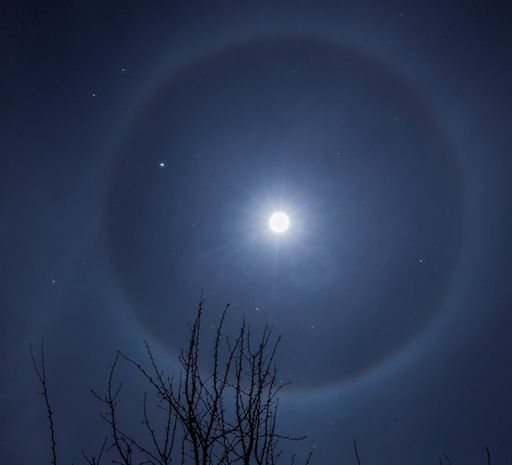 Astro Picture of the Day: January 14, 2014 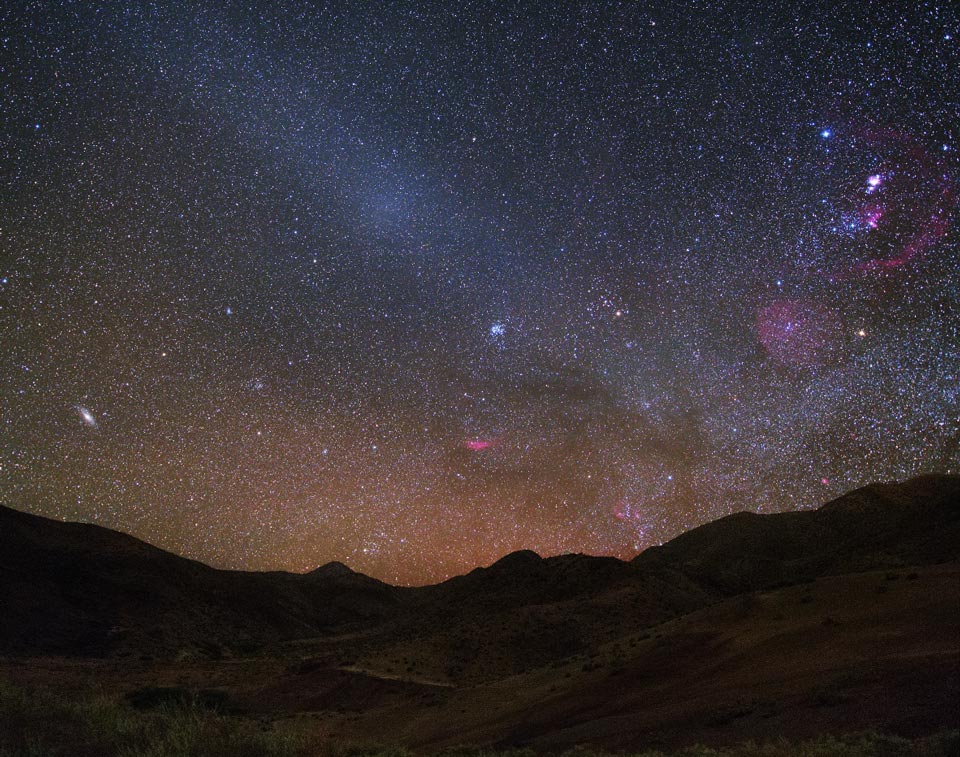 Is the night sky darkest in the direction opposite the Sun? No. In fact, a rarely discernable faint glow known as the gegenschein (German for "counter glow") can be seen 180 degrees around from the Sun in an extremely dark sky. The gegenschein is sunlight back-scattered off small interplanetary dust particles. These dust particles are millimeter sized splinters from asteroids and orbit in the ecliptic plane of the planets. Pictured above from last year is one of the more spectacular pictures of the gegenschein yet taken. Here a deep exposure of an extremely dark sky over Las Campanas Observatory in Chile shows the gegenschein so clearly that even a surrounding glow is visible. Notable background objects include the Andromeda galaxy, the Pleiades star cluster, the California Nebula, the belt of Orion just below the Orion Nebula and inside Barnard's Loop, and bright stars Sirius and Betelgeuse. The gegenschein is distinguished from zodiacal light near the Sun by the high angle of reflection. During the day, a phenomenon similar to the gegenschein called the glory can be seen in reflecting air or clouds opposite the Sun from an airplane.
__________________
1st in Kommisar's 2009 SM Tournament 1st in I Love You`s 2009 New Year`s Tournament 3rd in EnR's Mashfest '08 tournament 5th in Phynx's Unofficial FFR Tournament 9th in D3 of the 2008-2009 4th Official FFR Tournament 10th in D5 of the 2010 5th Official FFR Tournament 10th in D6 of the 2011-2012 6th Official FFR Tournament FMO AAA Count: 71 FGO AAA Count: 10 Bluearrowll = The Canadian player who can not detect awkward patterns. If it's awkward for most people, it's normal for Terry. If the file is difficult but super straight forward, he has issues. If he's AAAing a FGO but then heard that his favorite Hockey team was losing by a point, Hockey > FFR PS: Cool AAA's Terry - I Love You An Alarm Clock's Haiku beep beep beep beep beep beep beep beep beep beep beep beep beep beep beep beep beep - ieatyourlvllol |
|
|

|
|
|
#809 |
|
⊙▃⊙
|
Daily Suspicious0bserver's Weather Post:
January 15, 2014 What's in the sky tonight? January 15, 2014 -Full Moon (exact at 11:52 p.m. EST). This is the smallest full Moon of 2014. Jupiter shines above it in early evening. As the evening grows late, Jupiter swings to the Moon's upper right. -Science teacher Tom Wagner of Waterloo, Iowa, is an avid photographer of snowflakes. Over the years he has discovered a great way to catch large flakes in mid-air: "I blow a soap bubble and allow the snowflake to land on it," he explains. Once the snowflake is properly corralled, the photography is relatively easy. Last week when the Polar Vortex descended over Iowa, Wagner went outdoors to capture some more snowflakes. Just one problem: It was so cold outside, the soap bubbles themselves froze. "I made a decision to photograph these frozen bubbles on the snow," says Wagner. "The sun was 20 minutes from setting so I had to act fast. Most of the bubbles popped when they landed but with some practice I discovered a technique that resulted in quite a few remaining intact." "After a few pictures at home I hurried over to a nearby cemetery where there was still several more minutes of direct sunlight. The men digging nearby must have wondered what I was doing blowing little bubbles onto the snow then lying next to them with my camera in hand. Having the sun in the immediate background illuminated the fern-like crystals growing within the curved bubble skin."  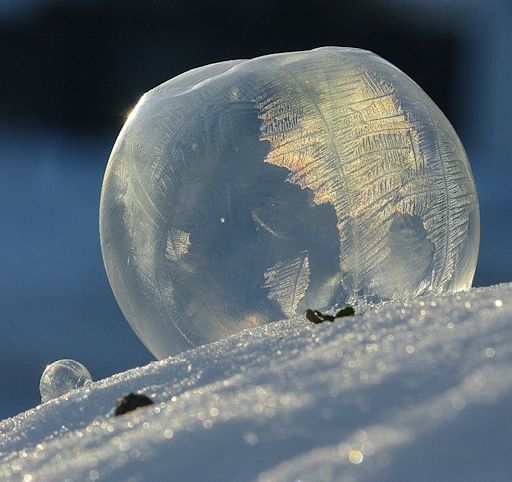 Astro Picture of the Day: January 15, 2014  Few cosmic vistas excite the imagination like the Orion Nebula, an immense stellar nursery some 1,500 light-years away. This stunning false-color view spans about 40 light-years across the region, constructed using infrared data from the Spitzer Space Telescope. Compared to its visual wavelength appearance, the brightest portion of the nebula is likewise centered on Orion's young, massive, hot stars, known as the Trapezium Cluster. But the infrared image also detects the nebula's many protostars, still in the process of formation, seen here in red hues. In fact, red spots along the dark dusty filament to the left of the bright cluster include the protostar cataloged as HOPS 68, recently found to have crystals of the silicate mineral olivine within its protostellar envelope. Crystal pictures: http://www.spitzer.caltech.edu/image...f-Crystal-Rain Crystal supporting papers: http://arxiv.org/pdf/1104.4498v1.pdf
__________________
1st in Kommisar's 2009 SM Tournament 1st in I Love You`s 2009 New Year`s Tournament 3rd in EnR's Mashfest '08 tournament 5th in Phynx's Unofficial FFR Tournament 9th in D3 of the 2008-2009 4th Official FFR Tournament 10th in D5 of the 2010 5th Official FFR Tournament 10th in D6 of the 2011-2012 6th Official FFR Tournament FMO AAA Count: 71 FGO AAA Count: 10 Bluearrowll = The Canadian player who can not detect awkward patterns. If it's awkward for most people, it's normal for Terry. If the file is difficult but super straight forward, he has issues. If he's AAAing a FGO but then heard that his favorite Hockey team was losing by a point, Hockey > FFR PS: Cool AAA's Terry - I Love You An Alarm Clock's Haiku beep beep beep beep beep beep beep beep beep beep beep beep beep beep beep beep beep - ieatyourlvllol |
|
|

|
|
|
#810 |
|
⊙▃⊙
|
Daily Suspicious0bserver's Weather Post:
January 16, 2014 What's in the sky tonight? January 16, 2014 -As the Moon climbs up in the east, spot Procyon to its upper right, bright Jupiter higher above them, and Sirius far right of the Moon in the southeast, under Orion. -NOAA forecasters estimate a 35% chance of polar geomagnetic storms on Jan. 17th when a minor CME is expected to hit Earth. High-latitude sky watchers should be alert for auroras competing with bright moonlight. -Last night's full Moon was the smallest of the year, as much as 14% smaller and 30% dimmer than other full Moons of 2014. But could you tell the difference? When the Moon is high in the sky with no reference points nearby, a big Moon and a small Moon look much the same. To set the scale of the phenomenon, Karzaman Ahmad of the Langkawi National Observatory in Maylasia photographed last night's Moon and placed it alongside a photo of the largest Moon from 2013. "It really was smaller!" he says. -Full Moons vary in size and brightness because of the oval shape of the Moon's orbit. The Moon follows an elliptical path around Earth with one side ("perigee") about 50,000 km closer than the other ("apogee"). Last night's full Moon was a distant apogee Moon--less big and bright, but no less beautiful. 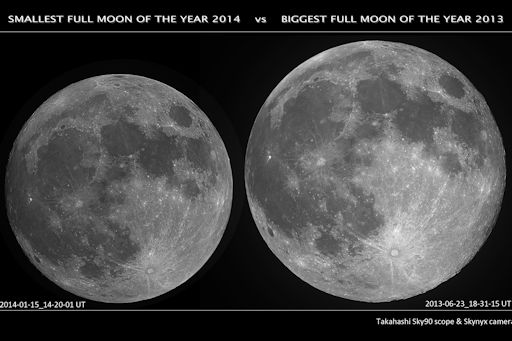 Astro Picture of the Day: January 16, 2014 Despina is a tiny moon of Neptune. A mere 148 kilometers across, diminutive Despina was discovered in 1989, in images from the Voyager 2 spacecraft taken during its encounter with the solar system's most distant gas giant planet. But looking through the Voyager 2 data 20 years later, amateur image processor and philosophy professor Ted Stryk discovered something no one had recognized before -- images that show the shadow of Despina in transit across Neptune's blue cloud tops. His composite view of Despina and its shadow is composed of four archival frames taken on August 24, 1989, separated by nine minutes. Despina itself has been artificially brightened to make it easier to see. In ancient Greek mythology, Despina is a daughter of Poseidon, the Roman god Neptune.
__________________
1st in Kommisar's 2009 SM Tournament 1st in I Love You`s 2009 New Year`s Tournament 3rd in EnR's Mashfest '08 tournament 5th in Phynx's Unofficial FFR Tournament 9th in D3 of the 2008-2009 4th Official FFR Tournament 10th in D5 of the 2010 5th Official FFR Tournament 10th in D6 of the 2011-2012 6th Official FFR Tournament FMO AAA Count: 71 FGO AAA Count: 10 Bluearrowll = The Canadian player who can not detect awkward patterns. If it's awkward for most people, it's normal for Terry. If the file is difficult but super straight forward, he has issues. If he's AAAing a FGO but then heard that his favorite Hockey team was losing by a point, Hockey > FFR PS: Cool AAA's Terry - I Love You An Alarm Clock's Haiku beep beep beep beep beep beep beep beep beep beep beep beep beep beep beep beep beep - ieatyourlvllol Last edited by Bluearrowll; 01-16-2014 at 08:32 PM.. |
|
|

|
|
|
#811 |
|
⊙▃⊙
|
Daily Suspicious0bserver's Weather Post:
January 17, 2014 What's in the sky tonight? January 17, 2014 -As the stars come out, face north and look very high overhead for Cassiopeia, oriented now like a flattened letter M. As the night proceeds, the M swings down in the northwest and tilts sideways. -NOAA forecasters estimate a 35% chance of polar geomagnetic storms on Jan. 17th when a minor CME is expected to hit Earth's magnetic field. High-latitude sky watchers should be alert for moonlit auroras. -Winter is unfolding around the northern hemisphere. As temperatures drop, pillars of light are springing up from ground. Janis Satrovskis of Valmiera, Latvia, photographed this specimen on Jan. 14th. Light pillars are a common sight around northern cities in winter. Urban lights bounce off ice crystals in the air, producing tall luminous columns sometimes mistaken for auroras. Usually the ice crystals are natural, such as snow flakes, but in this case the atmospheric optics were artificial. "The amazing phenomenon was created by snow blowing machines," explains Satrovskis. "These are our first days with temperatures below zero and ski resorts are making snow. A slight breeze carried manmade snow over the city, creating a spectacular view." Light pillars are springing up in cold cities around the world. Is yours one of them? 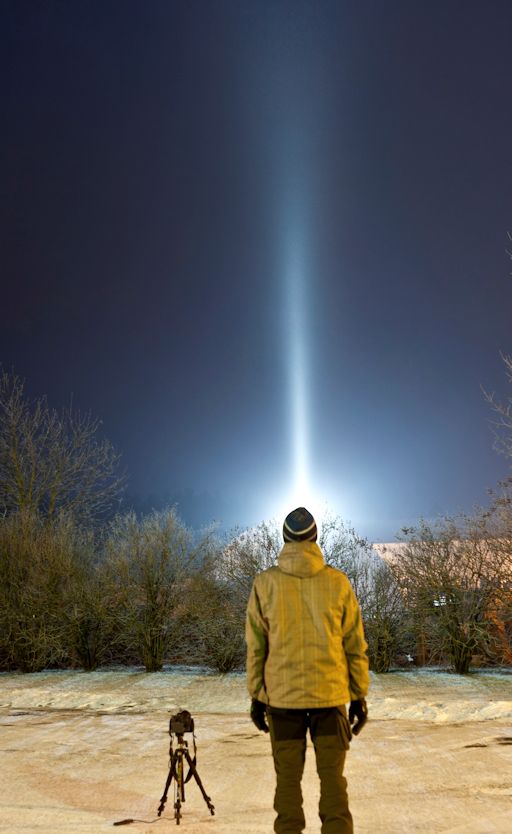 Astro Picture of the Day: January 17, 2014  Big, bright, and beautiful, spiral galaxy M83 lies a mere twelve million light-years away, near the southeastern tip of the very long constellation Hydra. This deep view of the gorgeous island universe includes observations from Hubble, along with ground based data from the European Southern Observatory's very large telescope units, National Astronomical Observatory of Japan's Subaru telescope, and Australian Astronomical Observatory photographic data by D. Malin. About 40,000 light-years across, M83 is popularly known as the Southern Pinwheel for its pronounced spiral arms. But the wealth of reddish star forming regions found near the edges of the arms' thick dust lanes, also suggest another popular moniker for M83, the Thousand-Ruby Galaxy. Arcing near the top of the novel cosmic portrait lies M83's northern stellar tidal stream, debris from the gravitational disruption of a smaller, merging satellite galaxy. The faint, elusive star stream was found in the mid 1990s by enhancing photographic plates.
__________________
1st in Kommisar's 2009 SM Tournament 1st in I Love You`s 2009 New Year`s Tournament 3rd in EnR's Mashfest '08 tournament 5th in Phynx's Unofficial FFR Tournament 9th in D3 of the 2008-2009 4th Official FFR Tournament 10th in D5 of the 2010 5th Official FFR Tournament 10th in D6 of the 2011-2012 6th Official FFR Tournament FMO AAA Count: 71 FGO AAA Count: 10 Bluearrowll = The Canadian player who can not detect awkward patterns. If it's awkward for most people, it's normal for Terry. If the file is difficult but super straight forward, he has issues. If he's AAAing a FGO but then heard that his favorite Hockey team was losing by a point, Hockey > FFR PS: Cool AAA's Terry - I Love You An Alarm Clock's Haiku beep beep beep beep beep beep beep beep beep beep beep beep beep beep beep beep beep - ieatyourlvllol |
|
|

|
|
|
#812 |
|
⊙▃⊙
|
Daily Suspicious0bserver's Weather Post:
January 18, 2014 What's in the sky tonight? January 18, 2014 -This the Big Dipper's time of year to swing up from the low north-northeast after dusk, to stand on its handle in the northeast by about 9 p.m. -Jupiter's Great Red Spot transits Jupiter's central meridian around 10:15 p.m. EST. -A minor CME expected to hit Earth's magnetic field on Jan. 17th is late, but NOAA forecasters still think it is coming. They estimate a 40% chance of polar geomagnetic storms on Jan. 18th in response to the tardy impact. High-latitude sky watchers should be alert for auroras. -Luminous halos around the Moon are nothing unusual, especially in wintertime Finland where the air is so often filled with ice. Crystals of frozen H2O catch the moonlight and bend it into a circular ring of light. A few nights ago, however, Sauli Koski of Muonio, Finland, witnessed a halo that was not circular, but elliptical. "On Jan. 15th, the weather changed. As the temperature dropped from -7C to -37C, there were all kinds of ice halos to photograph," says Koski. "The best and rarest were these elliptical forms that lasted more than 20 minutes." Although physicists have been studying ice halos for decades, not all are understood. "Elliptical halos are one of the puzzles," says atmospheric optics expert Les Cowley. " We can simulate them by invoking hexagonal plate-like crystals topped by almost flat pyramid faces. However, the simulations do not fit very well and such crystals are unphysical. Crystal facets like to form along planes where there are lots of atoms or molecules – almost flat pyramids do not fit the bill at all. Perhaps some peculiar distorted snowflake types instead?" "These mysteries all add to the spice of halo observing, the beautiful, the unexpected, the unexplained, something new!" -A sunspot approaching from just behind the sun's southeastern limb is crackling with solar flares. The explosions are registering C2 to C8 on the Richter Scale of Flares even though they are partially eclipsed by the edge of the sun. In Athens, Greece, amateur astronomer Peter Desypris photographed the flying debris from one of the explosions. "Indeed, something big appears to be on the way," says Desypris. The sun's rotation is slowly turning the active region toward Earth. During the weekend its core should emerge into plain view for a better evaluation of its flare-producing potential. Stay tuned for updates. 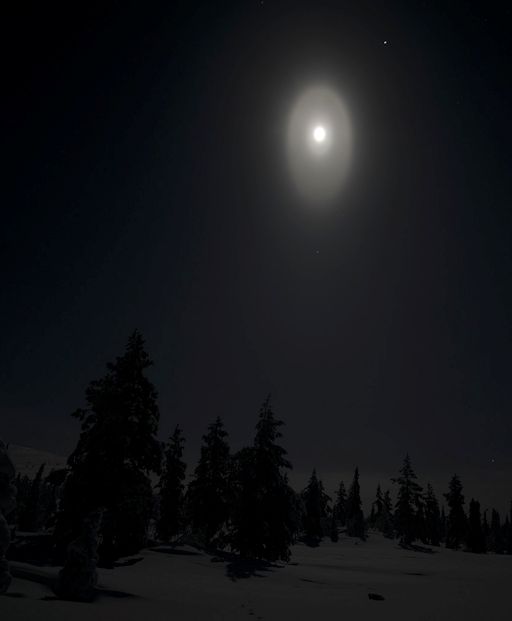 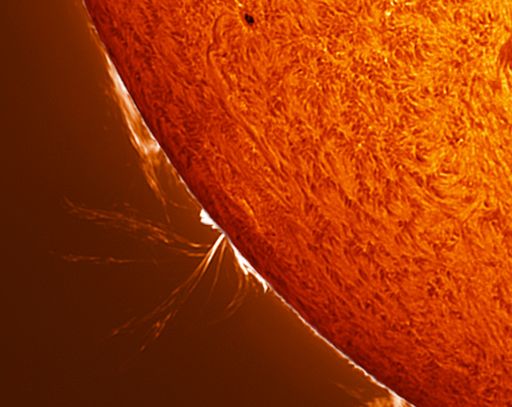 Astro Picture of the Day: January 18, 2014 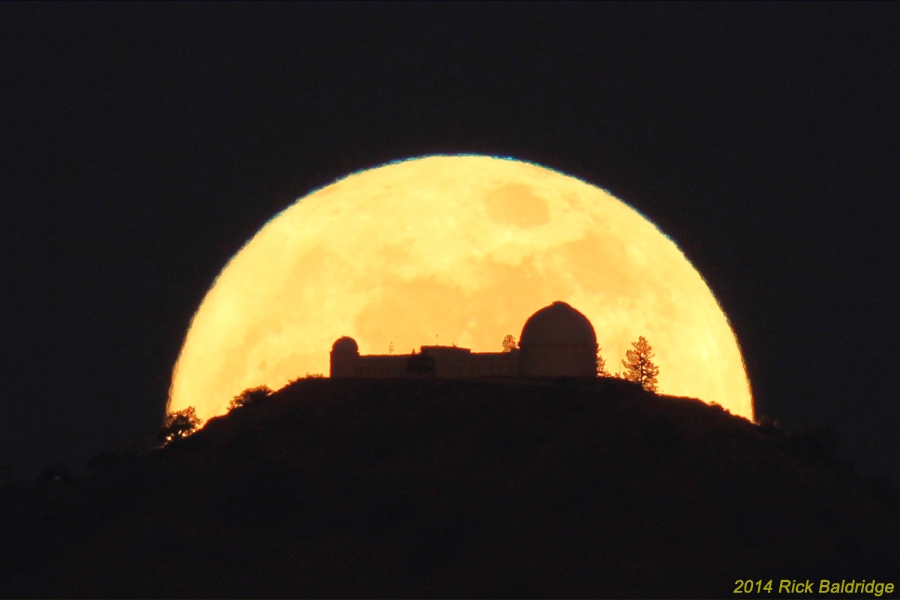 This big, bright, beautiful Full Moon rose over Lick Observatory Wednesday night. Traditionally a full moon in January might be called the Wolf Moon. But this moon reached its full phase on January 16, 4:54 UT, within about 2 hours of apogee, the most distant point in its elliptical orbit around planet Earth. That also makes it the smallest full moon of 2014. Of course the difference in apparent size between the largest and smallest full moons is hard to see, because the difference in distance between lunar apogee and perigee, or closest point in the Moon's orbit, is only about 50,000 kilometers, while the Moon's average distance is around 385,000 kilometers. Though not by much, this apogee's full moon was also the smallest full moon of the last 1,000 years. It will keep that distinction until a slightly smaller full moon occurs close to apogee in 2154.
__________________
1st in Kommisar's 2009 SM Tournament 1st in I Love You`s 2009 New Year`s Tournament 3rd in EnR's Mashfest '08 tournament 5th in Phynx's Unofficial FFR Tournament 9th in D3 of the 2008-2009 4th Official FFR Tournament 10th in D5 of the 2010 5th Official FFR Tournament 10th in D6 of the 2011-2012 6th Official FFR Tournament FMO AAA Count: 71 FGO AAA Count: 10 Bluearrowll = The Canadian player who can not detect awkward patterns. If it's awkward for most people, it's normal for Terry. If the file is difficult but super straight forward, he has issues. If he's AAAing a FGO but then heard that his favorite Hockey team was losing by a point, Hockey > FFR PS: Cool AAA's Terry - I Love You An Alarm Clock's Haiku beep beep beep beep beep beep beep beep beep beep beep beep beep beep beep beep beep - ieatyourlvllol |
|
|

|
|
|
#813 |
|
⊙▃⊙
|
Daily Suspicious0bserver's Weather Post:
January 19, 2014 What's in the sky tonight? January 19, 2014 -Sirius twinkles brightly after dinnertime below Orion in the southeast. Around 8 or 9 p.m., depending on your location, Sirius shines precisely below fiery Betelgeuse in Orion's shoulder. How accurately can you time this event for your location, perhaps using a plumb bob or the vertical edge of a building? Sirius leads early in the evening, Betelgeuse leads later. Welcome to pre-telescopic astronomy. -A phalanx of new sunspots rotating over the sun's southeastern limb was expected to boost solar activity this weekend. So far, however, the spots have not produced strong flares. Solar activity is low. Astro Picture of the Day: January 19, 2014 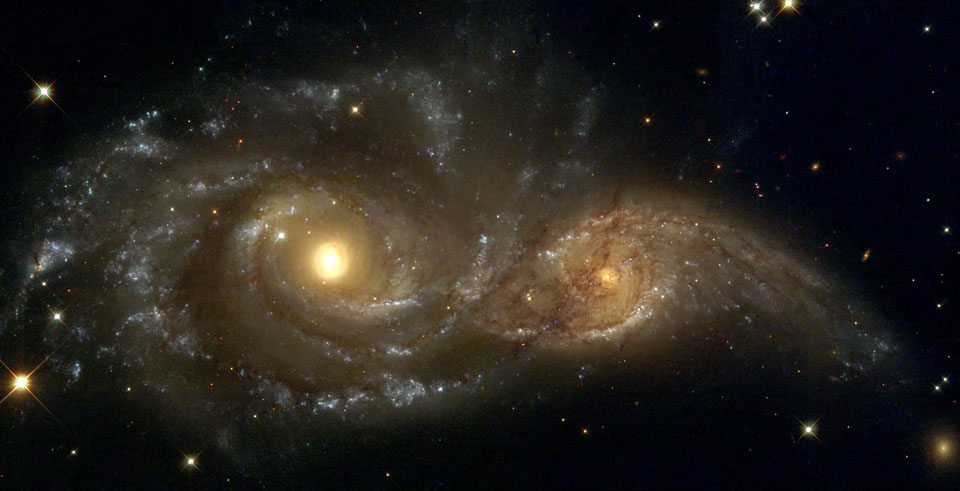 Billions of years from now, only one of these two galaxies will remain. Until then, spiral galaxies NGC 2207 and IC 2163 will slowly pull each other apart, creating tides of matter, sheets of shocked gas, lanes of dark dust, bursts of star formation, and streams of cast-away stars. Astronomers predict that NGC 2207, the larger galaxy on the left, will eventually incorporate IC 2163, the smaller galaxy on the right. In the most recent encounter that about peaked 40 million years ago, the smaller galaxy is swinging around counter-clockwise, and is now slightly behind the larger galaxy. The space between stars is so vast that when galaxies collide, the stars in them usually do not collide.
__________________
1st in Kommisar's 2009 SM Tournament 1st in I Love You`s 2009 New Year`s Tournament 3rd in EnR's Mashfest '08 tournament 5th in Phynx's Unofficial FFR Tournament 9th in D3 of the 2008-2009 4th Official FFR Tournament 10th in D5 of the 2010 5th Official FFR Tournament 10th in D6 of the 2011-2012 6th Official FFR Tournament FMO AAA Count: 71 FGO AAA Count: 10 Bluearrowll = The Canadian player who can not detect awkward patterns. If it's awkward for most people, it's normal for Terry. If the file is difficult but super straight forward, he has issues. If he's AAAing a FGO but then heard that his favorite Hockey team was losing by a point, Hockey > FFR PS: Cool AAA's Terry - I Love You An Alarm Clock's Haiku beep beep beep beep beep beep beep beep beep beep beep beep beep beep beep beep beep - ieatyourlvllol |
|
|

|
|
|
#814 |
|
⊙▃⊙
|
Daily Suspicious0bserver's Weather Post:
January 20, 2014 What's in the sky tonight? January 20, 2014 -Jupiter's moon Io crosses Jupiter's face from 8:07 to 10:22 p.m. EST, with its tiny black shadow (much more visible in a telescope) following 23 minutes behind. Later, Jupiter's Great Red Spot transits the planet's central meridian around 11:54 p.m. EST. -Venus (about magnitude –4.4) is now plain to see low in early dawn; look east-southeast. It too is becoming higher every day. -In a telescope Venus is a very thin, large crescent following its inferior conjunction on January 11th. Astro Picture of the Day: January 20, 2014 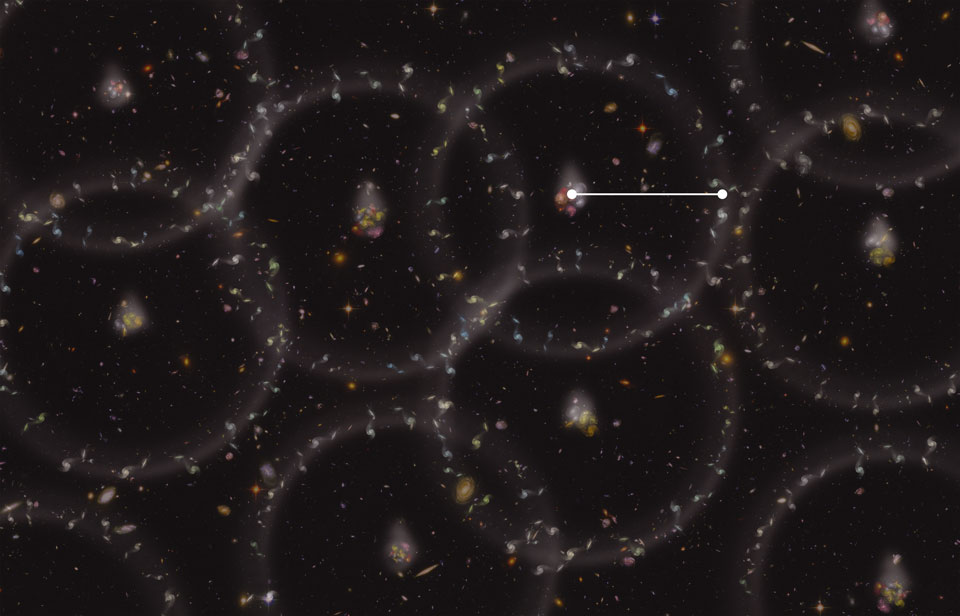 How large do things appear when far away? When peering across the universe, the answer can actually tell us about its average gravitational history and hence its composition. Toward this goal, the Baryon Oscillation Spectroscopic Survey (BOSS) of the Sloan Digital Sky Survey-III (SDSS-III) has measured slight recurring density enhancements in galaxy densities up to six billion light years away (redshift 0.7), when the universe was about half its current age. These density ripples are known as baryon acoustic oscillations (BAOs) and are expected to emerge from the early universe at a known size scale. BOSS's measurements of this size scale indicate a strong universe component of dark energy, and so bolsters previous indications of this unusual composition. Pictured above is an artist's illustration depicting exaggerated BAOs in the distant universe.
__________________
1st in Kommisar's 2009 SM Tournament 1st in I Love You`s 2009 New Year`s Tournament 3rd in EnR's Mashfest '08 tournament 5th in Phynx's Unofficial FFR Tournament 9th in D3 of the 2008-2009 4th Official FFR Tournament 10th in D5 of the 2010 5th Official FFR Tournament 10th in D6 of the 2011-2012 6th Official FFR Tournament FMO AAA Count: 71 FGO AAA Count: 10 Bluearrowll = The Canadian player who can not detect awkward patterns. If it's awkward for most people, it's normal for Terry. If the file is difficult but super straight forward, he has issues. If he's AAAing a FGO but then heard that his favorite Hockey team was losing by a point, Hockey > FFR PS: Cool AAA's Terry - I Love You An Alarm Clock's Haiku beep beep beep beep beep beep beep beep beep beep beep beep beep beep beep beep beep - ieatyourlvllol |
|
|

|
|
|
#815 |
|
⊙▃⊙
|
Daily Suspicious0bserver's Weather Post:
January 21, 2014 What's in the sky tonight? January 21, 2014 -The waning gibbous Moon rises around 11 tonight, then Mars and Spica follow up below it in the next hour and a quarter. By dawn Wednesday morning (the 22nd) the three are posing in the southwest, with Spica and Mars to the Moon's left and upper left as shown below. -Jupiter's Great Red Spot transits around 7:45 p.m. EST. -High-latitude auroras are possible on Jan. 21st when Earth crosses through a fold in the heliospheric current sheet. This is called a "solar sector boundary crossing," and NOAA forecasters estimate a 25% chance of polar geomagnetic storms when it occurs. -On Jan. 5th, Earth passed directly between the sun and Jupiter. Astronomers call this an "opposition" because the sun and Jupiter were on opposite sides of the sky. "Jupiter's opposition is always an opportunity for beautiful pictures of moons transiting Jupiter, sometimes directly in front of their own shadows," says John H. Rogers, Jupiter Section Director of the British Astronomical Association. "Observers have produced some fine examples from the opposition earlier this month." Some of the best are collected here.  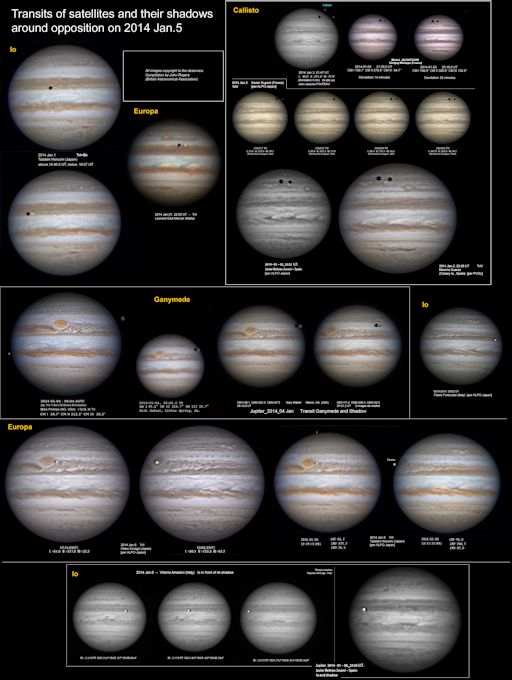 News Posted Today: January 20, 2014 The End of Rosetta's Big Sleep  Astro Picture of the Day: January 21, 2014  Did you see the big, bright, beautiful Full Moon last Wednesday night? That was actually a Micro Moon! On that night, the smallest Full Moon of 2014 reached its full phase only a few hours from lunar apogee, the time of its the most distant point from Earth in the Moon's elliptical orbit. Of course, last year on the night of June 22, a Full Super Moon was near perigee, the closest point in its orbit. The relative apparent size of January 15's Micro Moon is compared to the June 22 Super Moon in the above composite image digitally superimposing telescopic images from Perugia, Italy. The difference in apparent size represents a difference in distance of just under 50,000 kilometers between apogee and perigee, given the Moon's average distance of about 385,000 kilometers. How long do you have to wait to see another Full Micro Moon? Until March 5, 2015, when the lunar full phase will again occur within a few hours of lunar apogee.
__________________
1st in Kommisar's 2009 SM Tournament 1st in I Love You`s 2009 New Year`s Tournament 3rd in EnR's Mashfest '08 tournament 5th in Phynx's Unofficial FFR Tournament 9th in D3 of the 2008-2009 4th Official FFR Tournament 10th in D5 of the 2010 5th Official FFR Tournament 10th in D6 of the 2011-2012 6th Official FFR Tournament FMO AAA Count: 71 FGO AAA Count: 10 Bluearrowll = The Canadian player who can not detect awkward patterns. If it's awkward for most people, it's normal for Terry. If the file is difficult but super straight forward, he has issues. If he's AAAing a FGO but then heard that his favorite Hockey team was losing by a point, Hockey > FFR PS: Cool AAA's Terry - I Love You An Alarm Clock's Haiku beep beep beep beep beep beep beep beep beep beep beep beep beep beep beep beep beep - ieatyourlvllol |
|
|

|
|
|
#816 |
|
⊙▃⊙
|
Daily Suspicious0bserver's Weather Post:
January 22, 2014 What's in the sky tonight? January 22, 2014 -The waning Moon rises around midnight tonight very close to Spica, with Mars shining to their upper left. By dawn on the 23rd they move over to the southwest, with Mars now to the Moon's upper right as shown above. -Algol is at minimum brightness, magnitude 3.4 instead of its usual 2.3, for a couple hours centered on 1:20 a.m. Thursday morning EST (10:20 p.m. Wednesday PST). Algol takes several additional hours to fade and to rebrighten. -For the past 24 hours, solar activity has been low. However, two sunspots facing Earth, AR1957 and AR1959, have 'beta-gamma' magnetic fields that harbor energy for M-class solar flares. NOAA forecasters estimate a 30% chance of M-flares on Jan. 22nd. -Earth is entering a stream of solar wind blowing almost 600 km/s (1.3 million mph), and this is sparking auroras around the Arctic Circle. Just after nightfall on Jan. 21st, Harald Albrigtsen photographed the display over Kvaløya, Tromsø, Norway. "I caught the auroras just before the clouds arrived," says Albrigtsen, "so it was a lucky shot." More lucky shots are possible on Jan. 23 when a CME is expected to deliver a glancing blow to Earth's magnetic field, adding to the effect of the solar wind stream already here.  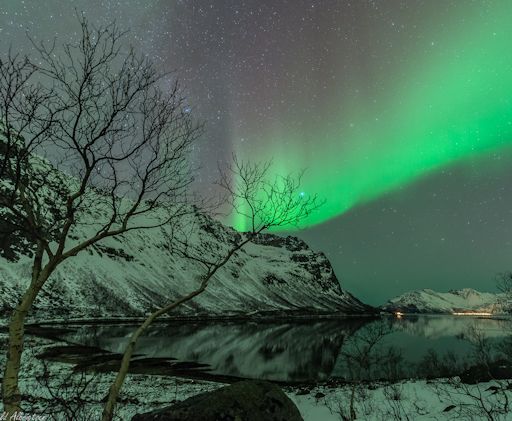 Astro Picture of the Day: January 22, 2014  Yes, but can your blizzard do this? In Upper Michigan's Storm of the Century in 1938, some snow drifts reached the level of utility poles. Nearly a meter of new and unexpected snow fell over two days in a storm that started 76 years ago tomorrow. As snow fell and gale-force winds piled snow to surreal heights; many roads became not only impassable but unplowable; people became stranded; cars, school buses and a train became mired; and even a dangerous fire raged. Fortunately only two people were killed, although some students were forced to spend several consecutive days at school. The above image was taken by a local resident soon after the storm. Although all of this snow eventually melted, repeated snow storms like this help build lasting glaciers in snowy regions of our planet Earth.
__________________
1st in Kommisar's 2009 SM Tournament 1st in I Love You`s 2009 New Year`s Tournament 3rd in EnR's Mashfest '08 tournament 5th in Phynx's Unofficial FFR Tournament 9th in D3 of the 2008-2009 4th Official FFR Tournament 10th in D5 of the 2010 5th Official FFR Tournament 10th in D6 of the 2011-2012 6th Official FFR Tournament FMO AAA Count: 71 FGO AAA Count: 10 Bluearrowll = The Canadian player who can not detect awkward patterns. If it's awkward for most people, it's normal for Terry. If the file is difficult but super straight forward, he has issues. If he's AAAing a FGO but then heard that his favorite Hockey team was losing by a point, Hockey > FFR PS: Cool AAA's Terry - I Love You An Alarm Clock's Haiku beep beep beep beep beep beep beep beep beep beep beep beep beep beep beep beep beep - ieatyourlvllol |
|
|

|
|
|
#817 |
|
⊙▃⊙
|
Daily Suspicious0bserver's Weather Post:
January 23, 2014 What's in the sky tonight? January 23, 2014 -Last-quarter Moon tonight (exact at 12:19 a.m. Friday morning EST). The Moon rises around 1 a.m. local time. To its upper right is the Mars-Spica pair, and rising to its lower left more than an hour later is Saturn. By dawn on the 24th they're lined up horizontally in the south to southwest. -Jupiter's Great Red Spot transits around 9:23 p.m. EST. -On Tuesday January 21st astronomers first noticed an 11th-magnitude supernova in the galaxy M82 in Ursa Major. It's in the evening sky in reach of amateur telescopes, and it may not be done brightening yet. Leonard Ellul-Mercer photographed it from his observatory in Malta on Jan. 22nd. -Although it is 12 million light years away, M82 is considered to be a next-door neighbor of the Milky Way. Indeed, this is the nearest supernova to Earth since SN 1993J exploded 21 years ago. The relative proximity of the blast makes it an attractive target for astronomers to study. Light curves from previous supernovas of this type suggest that the fireball could continue to brighten for the next two weeks.  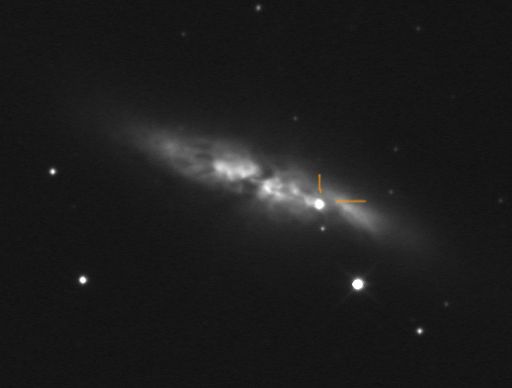 News Posted Today: January 22, 2014 Bright Supernova in M82  Astro Picture of the Day: January 23, 2014 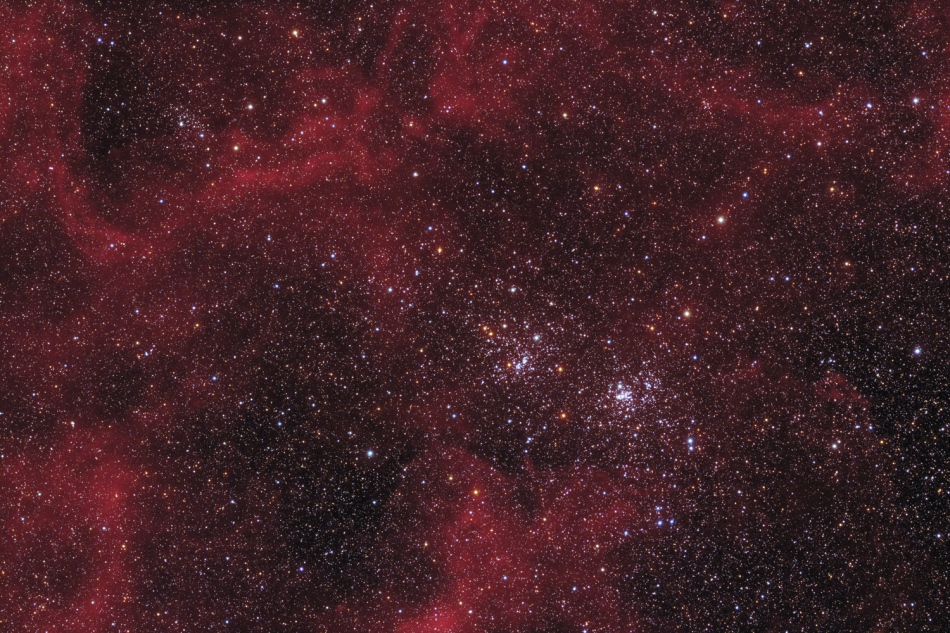 This lovely starfield spans some seven full moons (about 3.5 degrees) across the heroic northern constellation of Perseus. Just right of center it holds the famous pair of open or galactic star clusters, h and Chi Perseii. Also cataloged as NGC 869 (right) and NGC 884, both clusters are about 7,000 light-years away and contain stars much younger and hotter than the Sun. Separated by only a few hundred light-years, the clusters are both 13 million years young based on the ages of their individual stars, evidence that they were likely a product of the same star-forming region. Always a rewarding sight in binoculars, the Double Cluster is even visible to the unaided eye from dark locations. Not seen in binoculars though, and not often depicted in telescopic images of the region are faint clouds of reddish ionized hydrogen gas found throughout this remarkable cosmic skyscape. A color composite, the image includes narrowband data to enhance emission from the hydrogen clouds. Visible toward the upper left of the wide field of view is another, smaller open star cluster, NGC 957, also of similar age, distance, and possibly related to the more famous Double Cluster in Perseus.
__________________
1st in Kommisar's 2009 SM Tournament 1st in I Love You`s 2009 New Year`s Tournament 3rd in EnR's Mashfest '08 tournament 5th in Phynx's Unofficial FFR Tournament 9th in D3 of the 2008-2009 4th Official FFR Tournament 10th in D5 of the 2010 5th Official FFR Tournament 10th in D6 of the 2011-2012 6th Official FFR Tournament FMO AAA Count: 71 FGO AAA Count: 10 Bluearrowll = The Canadian player who can not detect awkward patterns. If it's awkward for most people, it's normal for Terry. If the file is difficult but super straight forward, he has issues. If he's AAAing a FGO but then heard that his favorite Hockey team was losing by a point, Hockey > FFR PS: Cool AAA's Terry - I Love You An Alarm Clock's Haiku beep beep beep beep beep beep beep beep beep beep beep beep beep beep beep beep beep - ieatyourlvllol |
|
|

|
|
|
#818 |
|
⊙▃⊙
|
Daily Suspicious0bserver's Weather Post:
January 24, 2014 What's in the sky tonight? January 24, 2014 -Mercury has become easy to see; look for it low in the west-southwest as twilight fades. Don't confuse it with twinkly Fomalhaut off to its left in the southwest. Mercury is beginning its best evening apparition since last June for mid-northern skywatchers. -The Moon rises around 2 a.m. Saturday morning the 25th with Saturn glowing just 1° or 2° from it (as seen from the Americas). They're high in the south together by dawn, as shown here. News Posted Today: January 23, 2014 "Dwarf Planet" Ceres Exhales Water  Astro Picture of the Day: January 24, 2014 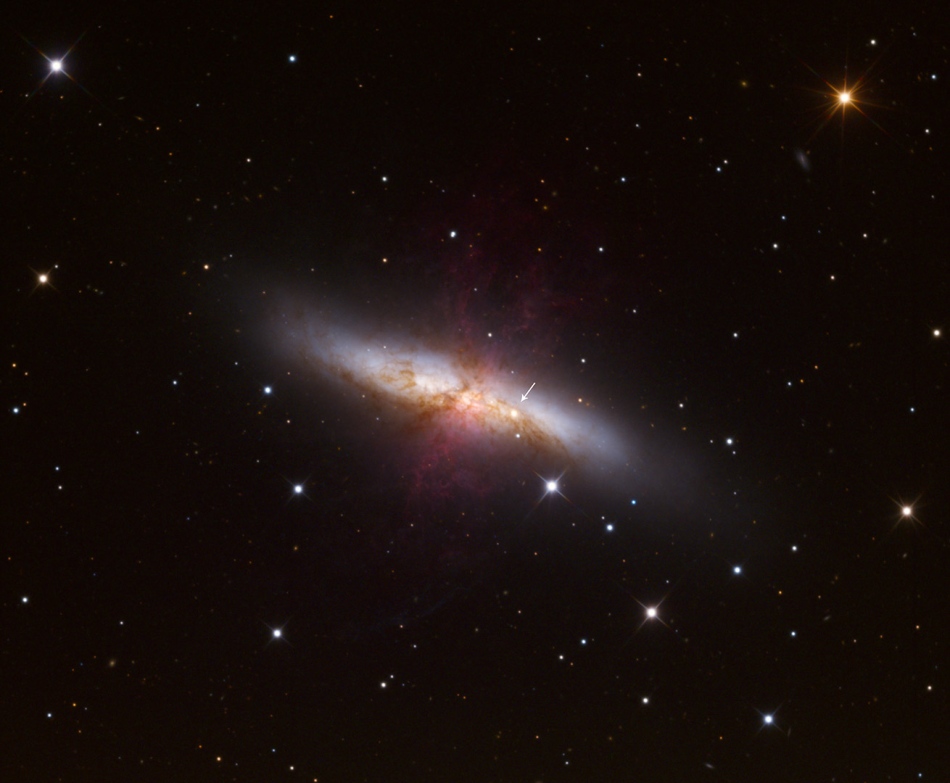 Astronomers really don't find supernovae by looking for the arrows. But in this image taken January 23rd, an arrow does point to an exciting, new supernova, now cataloged as SN 2014J, in nearby bright galaxy M82. Located near the Big Dipper in planet Earth's sky, M82 is also known as the Cigar Galaxy, a popular target for telescopes in the northern hemisphere. In fact, SN 2014J was first spotted as an unfamiliar source in the otherwise familiar galaxy by teaching fellow Steve Fossey and astronomy workshop students Ben Cooke, Tom Wright, Matthew Wilde and Guy Pollack at the University College London Observatory on the evening of January 21. M82 is a mere 12 million light-years away (so the supernova explosion did happen 12 million years ago, that light just now reaching Earth), making supernova SN 2014J one of the closest to be seen in recent decades. Spectra indicate it is a Type Ia supernova caused by the explosion of a white dwarf accreting matter from a companion star. By some estimates two weeks away from its maximum brightness, SN 2014J is already the brightest part of M82 and visible in small telescopes in the evening sky.
__________________
1st in Kommisar's 2009 SM Tournament 1st in I Love You`s 2009 New Year`s Tournament 3rd in EnR's Mashfest '08 tournament 5th in Phynx's Unofficial FFR Tournament 9th in D3 of the 2008-2009 4th Official FFR Tournament 10th in D5 of the 2010 5th Official FFR Tournament 10th in D6 of the 2011-2012 6th Official FFR Tournament FMO AAA Count: 71 FGO AAA Count: 10 Bluearrowll = The Canadian player who can not detect awkward patterns. If it's awkward for most people, it's normal for Terry. If the file is difficult but super straight forward, he has issues. If he's AAAing a FGO but then heard that his favorite Hockey team was losing by a point, Hockey > FFR PS: Cool AAA's Terry - I Love You An Alarm Clock's Haiku beep beep beep beep beep beep beep beep beep beep beep beep beep beep beep beep beep - ieatyourlvllol |
|
|

|
|
|
#819 |
|
⊙▃⊙
|
Daily Suspicious0bserver's Weather Post:
January 25, 2014 What's in the sky tonight? January 25, 2014 -Algol is at minimum brightness, magnitude 3.4 instead of its usual 2.3, for a couple hours centered on 10:09 p.m. EST. It takes several additional hours to fade and to rebrighten. -Jupiter's Great Red Spot transits Jupiter's central meridian around 11:01 p.m. EST. -With no sunspots actively flaring, the sun's x-ray output has flatlined. Solar activity is low and likely to remain so for the rest of the weekend. -The students of Earth to Sky Calculus are only hours away from launching another space weather balloon. The launch, slated for midday Pacific time on Jan. 25th, is the latest in a series of suborbital balloon missions designed to study the effects of solar activity on Earth's upper atmosphere. Today's flight samples a period of low solar activity, the opposite of their previous flight, which flew into the teeth of an S2-class solar radiation storm. The storm data they gathered on Jan. 8th is found below. The curve traces the amount of ionizing radiation encountered by the balloon during its 2 hour flight. During the ascent, an onboard x-ray/gamma-ray sensor measured doses 25 times greater than at ground level. The peak occured at the entrance to the stratosphere in a zone known as the "Pfotzer Maximum." Named after physicist George Pfotzer, who discovered the peak using balloons and Geiger tubes in the 1930s, the Pfotzer Maximum is produced by energetic particles hitting Earth's atmosphere, creating a spray of subatomic debris at high altitudes. The Earth to Sky campaign aims to find out, among other things, how the Pfotzer Maximum moves around in response to solar storms. This weekend's flight will repeat the Jan. 8th experiment using the same equipment while no solar radiation storm is in progress.  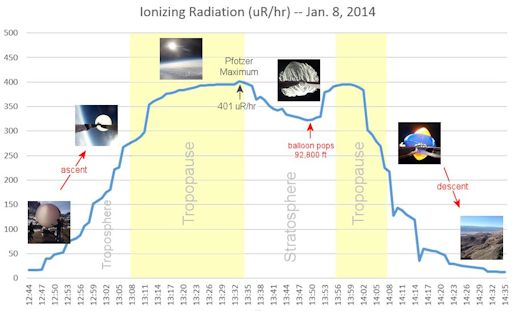 Astro Picture of the Day: January 25, 2014 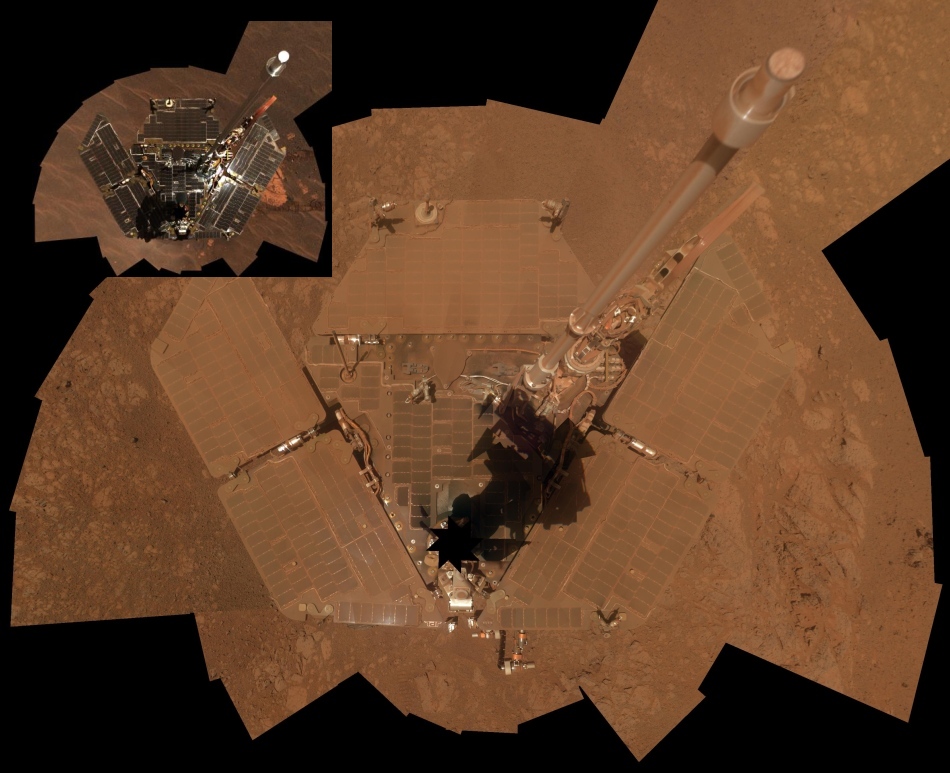 On January 25 (UT) 2004, the Opportunity rover fell to Mars, making today the 10th anniversary of its landing. After more than 3,500 sols (Mars solar days) the golf cart-sized robot from Earth is still actively exploring the Red Planet, though its original mission plan was for three months. This self-portrait was made with Opportunity's panoramic camera earlier this month. The camera's supporting mast has been edited out of the image mosaic but its shadow is visible on the dusty solar panels arrayed across the rover's deck. For comparison, a similar self-portrait from late 2004 is shown in the inset. Having driven some 39 kilometers (24 miles) from its landing site, Opportunity now rests at Solander Point at the rim of Endeavour Crater.
__________________
1st in Kommisar's 2009 SM Tournament 1st in I Love You`s 2009 New Year`s Tournament 3rd in EnR's Mashfest '08 tournament 5th in Phynx's Unofficial FFR Tournament 9th in D3 of the 2008-2009 4th Official FFR Tournament 10th in D5 of the 2010 5th Official FFR Tournament 10th in D6 of the 2011-2012 6th Official FFR Tournament FMO AAA Count: 71 FGO AAA Count: 10 Bluearrowll = The Canadian player who can not detect awkward patterns. If it's awkward for most people, it's normal for Terry. If the file is difficult but super straight forward, he has issues. If he's AAAing a FGO but then heard that his favorite Hockey team was losing by a point, Hockey > FFR PS: Cool AAA's Terry - I Love You An Alarm Clock's Haiku beep beep beep beep beep beep beep beep beep beep beep beep beep beep beep beep beep - ieatyourlvllol |
|
|

|
|
|
#820 |
|
⊙▃⊙
|
Did some performance updates on the opening post so that it hopefully doesn't take as long to load. Archives were moved to subsequent pages.
Daily Suspicious0bserver's Weather Post: January 26, 2014 What's in the sky tonight? January 26, 2014 -This is the frigid time of year when the Little Dipper (mostly dim) hangs straight down from Polaris shortly after dark. Look due north. -Northern sunspot AR1957 has a 'beta-gamma' magnetic field that harbors energy for M-class solar flares. The region's persistant quiet, however, suggests the odds of an eruption are low. NOAA forecasters estimate a 15% chance of M-flares on Jan. 26th. -Yesterday, the students of Earth to Sky Calculus launched a suborbital helium balloon from Bishop, California, and recovered the payload hours later from a nearby canyon. The goal of the mission was to measure high-energy radiation levels in the stratosphere. Those data are being reduced now. The students also captured panoramic images of California's epic drought. So much for the Golden State. The landscape of California is remarkably brown as the driest winter in more than a century unfolds. The drought is so bad that the city of Bishop, where the students go to school, looks like a settlement on the planet Mars. Image is below. "Up and down California, from Oregon to Mexico, it's dry as a bone," comments JPL climatologst Bill Patzert. "To make matters worse, the snowpack in the water-storing Sierras is less than 20% of normal for this time of the year." Indeed, the towering Sierras, only sparsely covered by crusty month-old snow, lack their usual white reflectance in many of the group's edge of space photos. Not much water will be flowing from those peaks to urban areas when the snow melts in spring. Water rationing and wildfires are likely this summer.    Astro Picture of the Day: January 26, 2014  It was a quiet day on the Sun. The above image shows, however, that even during off days the Sun's surface is a busy place. Shown in ultraviolet light, the relatively cool dark regions have temperatures of thousands of degrees Celsius. Large sunspot group AR 9169 from the last solar cycle is visible as the bright area near the horizon. The bright glowing gas flowing around the sunspots has a temperature of over one million degrees Celsius. The reason for the high temperatures is unknown but thought to be related to the rapidly changing magnetic field loops that channel solar plasma. Large sunspot group AR 9169 moved across the Sun during 2000 September and decayed in a few weeks.
__________________
1st in Kommisar's 2009 SM Tournament 1st in I Love You`s 2009 New Year`s Tournament 3rd in EnR's Mashfest '08 tournament 5th in Phynx's Unofficial FFR Tournament 9th in D3 of the 2008-2009 4th Official FFR Tournament 10th in D5 of the 2010 5th Official FFR Tournament 10th in D6 of the 2011-2012 6th Official FFR Tournament FMO AAA Count: 71 FGO AAA Count: 10 Bluearrowll = The Canadian player who can not detect awkward patterns. If it's awkward for most people, it's normal for Terry. If the file is difficult but super straight forward, he has issues. If he's AAAing a FGO but then heard that his favorite Hockey team was losing by a point, Hockey > FFR PS: Cool AAA's Terry - I Love You An Alarm Clock's Haiku beep beep beep beep beep beep beep beep beep beep beep beep beep beep beep beep beep - ieatyourlvllol |
|
|

|
 |
| Currently Active Users Viewing This Thread: 1 (0 members and 1 guests) | |
|
|